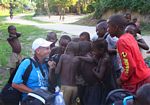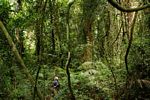Wursten, Bart (Barend) Theodorus
List: records (26506) | collections (3152) | images (18489) | determinations (14555) | confirmations (384) made by Bart Wursten
The above links show records made of species which occur in Zambia. The actual records may have been made anywhere.
Summarise: records by year Map: records by QDS
General Information
Date of birth: 17 Nov 1953 BiographyBart was born and raised in Amsterdam, the Netherlands. Although he was a real city kid, he always had a great love of nature and was collecting sea shells and watching birds even as a youngster. The rather wild days of his teens in Amsterdam during the late sixties and early seventies temporarily pushed these interests into the background. After (finally) finishing High School in 1974, he went to work at a Social Security Institute. He soon got the opportunity to get an education as a COBOL computer programmer. This being the days of feeding punch cards into a computer the size of a large room with less capacity than the average cell phone has these days. Soon realising this profession was not as exciting as he had first thought, he started freelancing as a pop music photographer. However, some small voice in the back of his mind, kept whispering that there was another life waiting out there, elsewhere in this world. He first came to Africa in 1984 when he travelled through what was then Zaire, Burundi and Tanzania. Everything that could go wrong during this trip, went wrong and he found himself stranded in Nairobi for a week and in Kinshasa for 5 days before being able to return home. Despite this, his love affair with Africa had started. After several short trips in Kenya, he burned his bridges in Holland and took off to Africa in 1986. He travelled extensively through many countries in Central, East and Southern Africa, arriving for the first time in Zimbabwe in June 1988. At this time both Zimbabwe and Botswana were virtually undiscovered by tourists but Bart quickly realised that not only was there great potential, facilities and infrastructure were actually much better than in other countries that were popular with tourists, such as Kenya, Tanzania or Malawi. He got the opportunity to set up one of the first organised safaris in these countries for a Dutch tour operator. For the next 10 years he guided groups of tourists through Zimbabwe and Botswana, visiting all the top spots in these countries, such as Matobo, Hwange, Makgadikgadi, Okavango, Moremi, Chobe, Victoria Falls, Nyanga and the Vumba Mountains. During the off-season he travelled elsewhere on the continent, preferably by bicycle, reaching even remote places in central Zaire, Uganda and Somalia. Of all the places he visited, one soon stole his heart more than any other and that was Vumba. In early 1998 he got the chance to buy a property there. With his wife Petra Ballings, who he had met during his safari days, he built up a small guesthouse called Ndundu Lodge. Zimbabwe was at its peak of the tourism boom and Ndundu Lodge looked like it would be the ideal place to settle at last. Unfortunately the new realities of Zimbabwe after 2000 soon shattered the hopes of an easy, comfortable and lucrative life in the hospitality business. However, the absence of tourists offered plenty time to enjoy the natural diversity of the Vumba and the mind blowing diversity of trees, ferns, orchids and other plants quickly sparked a passion for all things botanical. The arrival of new technical gadgets like laptop computers and digital photography opened up all kinds of possibilities to document all this. Bart first met Mark Hyde in 2003 during a Tree Society outing in the Vumba Mts. They soon discovered they were each working on similar ideas to document the flora of Zimbabwe. They decided that combining Mark's far greater knowledge and Bart's experience in photography could produce good results and the online Zimbabwe Flora was born. The rest, as one says, is history. In 2006, based on their experiences with eco-tourism in mountain habits, Bart and Petra were offered to work for Carr Foundation, which privately funded a project to rehabilitate the Gorongosa National Park in Mozambique and protect the biodiversity on near-by Mt Gorongosa. Among other things, Bart guided trips up the mountain to look for the Green-headed Oriole; they organised a vegetation survey on the mountain with Tom Muller and built up a herbarium collection of the plants of the National Park as well as the mountain. Disaster struck in September 2007, when Ndundu Lodge was destroyed by fire and again in June 2008 when, during the turbulent election period in Zimbabwe, their home was invaded and plundered. Their contract with Carr Foundation finished, they found themselves without home or income and saw themselves forced to return to Belgium, Petra's original home. Bart and Petra both still continue to work on the Zimbabwe Flora and try to return to Zimbabwe at least once a year. Bart also worked with the National Botanic Garden of Belgium and participated in a 6-week biodiversity expedition on the Congo River in 2010, as well as for a tree identification project of 21 forest plots in Yangambi. (2012-2013). Since 2013 Bart has been involved again with Gorongosa National Park, where he works several time each year for the EO Wilson Biodiversity Laboratory, participating in biodiversity surveys and teaching surveys for Mozambican students. During the latter the students are made familiar with field techniques and data collecting. Bart, together with Petra, also set up a herbarium at the EO Wilson Lab and trained staff to run it. |


